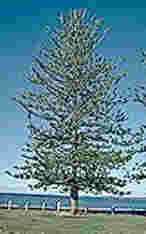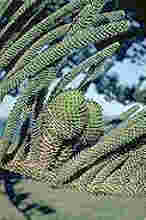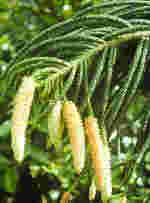
A tree (2).

Immature cones (2).
Pollen cones on a tree in the Dominican Republic (Dan Skean 1992) (3).
Common Names
Norfolk Island pine.Taxonomic notes
Syn: A. excelsa R. Br. ex Aiton, in part (1); Dombeya excelsa D.Don; Eutassa heterophylla Salis.Description
"A conical tree 50-70 m. tall, 1.25-1.75 m. in girth. Bark gray-brown, exfoliating in fine scales. Branches in a flat horizontal plane, sometimes pendent, branchlets in whorls of 4-7. Foliage dimorphic. Juvenile leaves awl-shaped, incurved, green, needle-like, to 1.2 cm. long. Adult leaves scale-like, 4-5 mm. long, incurved, densely arranged, bright dark green; on fertile branchlets overlapping, broadly ovate, spine-tipped, 6 mm. long by 4-6 mm. wide. Male cone in clusters, elongated, 4 cm. long, yellowish-brown or reddish; microsporophylls acute, margins ciliate, denticulate. Female cone broader than long, 12-15 cm. long, with triangular scales and a long incurved bract. Seeds 2.5-3 cm. long by 1.2 cm. wide, with broad wings. Cotyledons 4, epigeal" (1).Range
Endemic to lowland areas of Norfolk Island, a small island (about 10 square kilometers) about 1500 km east of Australia (1).Big Tree
Trees as tall as 57 m with an 350 cm diameter have been recorded. One of the largest remaining trees, the Hollow Pine, can be seen in the National Park on Norfolk Island (2). Some very large trees are found elsewhere; a specimen 218 cm dbh and 41 m tall grows at the Waitangi Treaty Grounds in New Zealand, and one 178 cm dbh and 45 m tall on Manukau Road, Epsom, New Zealand (4).Oldest
Dendrochronology
Ethnobotany
"Captain Cook thought the pine would provide 'Masts for the largest Ships' but it was found later to be unsuitable for masts. It proved a useful timber for other purposes however" (2).This is the araucaria most widely used as an ornamental.
Observations
Have seen specimens ca. 1.5m dbh and 40 m tall at a winery in south Maui (USA: Hawaii).Remarks
"Young trees have an almost symmetrical form for the first 40 years or so. Female cones are produced on trees older than 15 years and male cones on trees older than 40 years. Prolific seed fall occurs every 4-5 [years] and the seeds are a popular food source for the Green Parrot and introduced rats" (2).For pollination mechanisms, see Araucaria.
Citations
(1) Silba 1986.(2) Norfolk Island Botanical Gardens home page.
(3) Albion University web page.
(4) Burstall & Sale.
[ Araucaria ] [ Araucariaceae ] [ home ]
This page is from the Gymnosperm Database
URL: http://www.geocities.com/RainForest/Canopy/2285/ar/ar/heterophylla.htm
Edited by Christopher J. Earle
E-mail:
earlecj@earthlink.net
Last modified on 21-Dec-98
